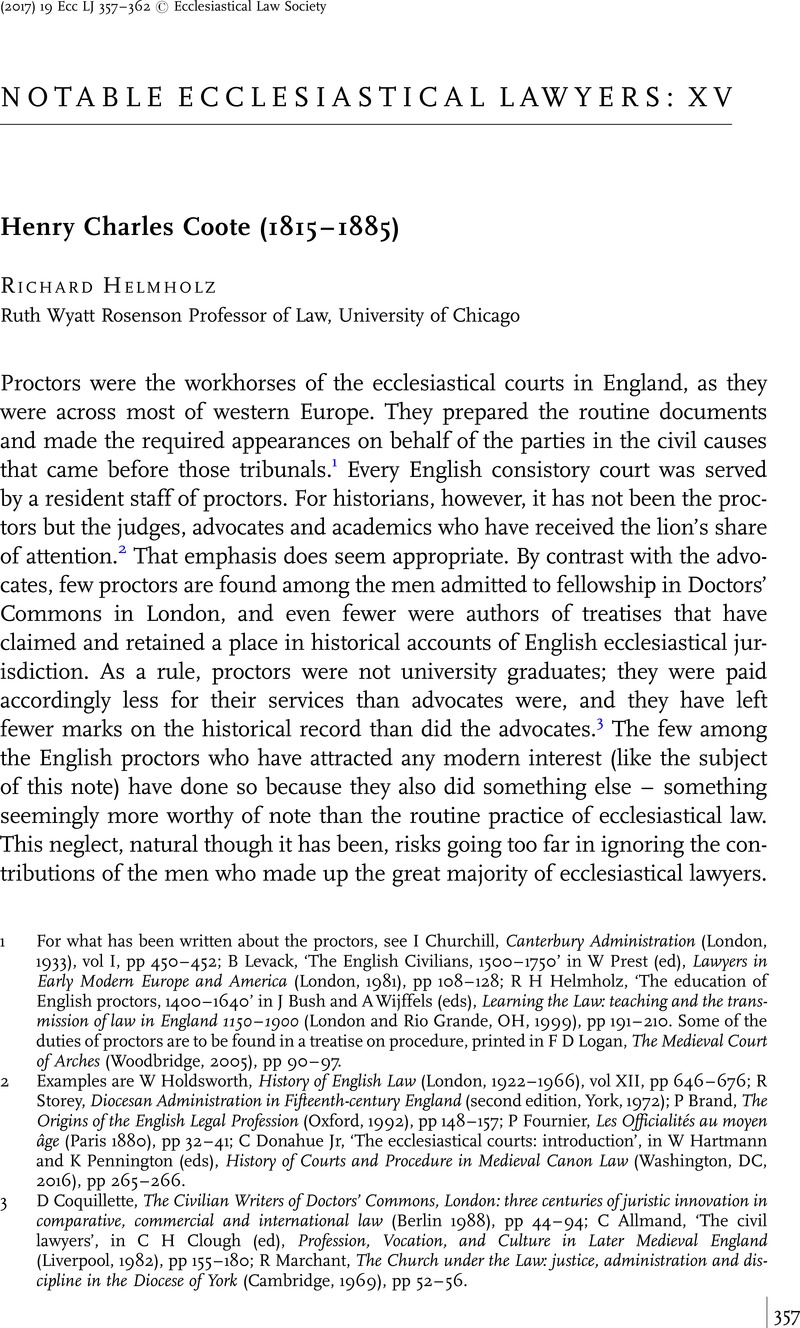No CrossRef data available.
Published online by Cambridge University Press: 31 August 2017

1 For what has been written about the proctors, see Churchill, I, Canterbury Administration (London, 1933), vol I, pp 450–452 Google Scholar; Levack, B, ‘The English Civilians, 1500–1750’ in Prest, W (ed), Lawyers in Early Modern Europe and America (London, 1981), pp 108–128 Google Scholar; Helmholz, R H, ‘The education of English proctors, 1400–1640’ in Bush, J and Wijffels, A (eds), Learning the Law: teaching and the transmission of law in England 1150–1900 (London and Rio Grande, OH, 1999), pp 191–210 Google Scholar. Some of the duties of proctors are to be found in a treatise on procedure, printed in Logan, F D, The Medieval Court of Arches (Woodbridge, 2005), pp 90–97 Google Scholar.
2 Examples are Holdsworth, W, History of English Law (London, 1922–1966), vol XII, pp 646–676 Google Scholar; Storey, R, Diocesan Administration in Fifteenth-century England (second edition, York, 1972)Google Scholar; Brand, P, The Origins of the English Legal Profession (Oxford, 1992), pp 148–157 Google Scholar; Fournier, P, Les Officialités au moyen âge (Paris 1880), pp 32–41 Google Scholar; Donahue, C Jr, ‘The ecclesiastical courts: introduction’, in Hartmann, W and Pennington, K (eds), History of Courts and Procedure in Medieval Canon Law (Washington, DC, 2016), pp 265–266 Google Scholar.
3 Coquillette, D, The Civilian Writers of Doctors’ Commons, London: three centuries of juristic innovation in comparative, commercial and international law (Berlin 1988), pp 44–94 Google Scholar; Allmand, C, ‘The civil lawyers’, in Clough, C H (ed), Profession, Vocation, and Culture in Later Medieval England (Liverpool, 1982), pp 155–180 Google Scholar; Marchant, R, The Church under the Law: justice, administration and discipline in the Diocese of York (Cambridge, 1969), pp 52–56 Google Scholar.
4 Coote, C, Sketches of the Lives and Characters of Eminent English Civilians (London, 1804)Google Scholar.
5 Ibid, p 133.
6 Squibb, G D, Doctors’ Commons: A history of the College of Advocates and Doctors of Law (Oxford, 1977), p 195Google Scholar.
7 See J Ayliffe, Parergon: juris canonici Anglicani, tit ‘Of last wills and testaments, codicils etc.’ (London, 1726), p 534; Kitching, C, ‘The Prerogative Court of Canterbury from Warham to Whitgift’, in O'Day, R and Heale, F (eds), Continuity and Change: personnel and administration of the Church of England, 1500–1640 (Leicester, 1976), pp 191–214 Google Scholar.
8 Coote, H C, Practice of the Ecclesiastical Courts with Forms and Tables of Costs (London, 1847), p 31Google Scholar.
9 Court of Probate Act, 20 & 21 Vict c 77 (1857).
10 Squibb, Doctors’ Commons, pp 102–109.
11 Baker, J H, Monuments of Endlesse Labours: English canonists and their work 1300–1900 (London and Rio Grande, OH, 1998), p 169Google Scholar.
12 A ‘third supplement’ to this edition was published in 2010.
13 Coote, H C, The New Practice of the High Court of Admiralty of England (London, 1860)Google Scholar.
14 [Anon], ‘Coote, Henry Charles (1815–1885)’, rev Banerji, Nilanjana, Oxford Dictionary of National Biography (Oxford, 2004)Google Scholar, <http://www.oxforddnb.com/view/article/6245>, accessed 17 Nov 2016.
15 See Hudson, J, The Oxford History of the Laws of England, Volume II 871–1216 (Oxford, 2012)Google Scholar; Wormald, P, The Making of English Law: King Alfred to the twelfth century, volume I: legislation and its limits (Oxford, 1999)Google Scholar; Richardson, H G and Sayles, G O, Law and Legislation from Æthelberht to Magna Carta (Edinburgh, 1966)Google Scholar. None mentions Coote's work.
16 It was so described in the ODNB entry noted above (n 14).
17 An informative predecessor, also compiled by a proctor, was Oughton, T, Ordo judiciorum; sive methodus procedendi in negotiis et litibus in foro ecclesiastico-civili (London, 1738)Google Scholar.
18 See eg Owen, D M, Ely Records: a handlist of the records of the Bishop and Archdeacon of Ely (Cambridge, 1971), pp 29–34 Google Scholar.
19 Some have also been dispersed across the world. The University of Chicago, for example, has a copy: Joseph Regenstein Library, Special Collections, MS 1660.
20 See Holdsworth, History of English Law, vol V, pp 383–386.
21 Helmholz, R H, Marriage Litigation in Medieval England (Cambridge, 1974), p 22Google Scholar.
22 Coote, H C, The Practice of the Ecclesiastical Courts (London, 1847), p 102Google Scholar.
23 Ibid, pp 158–176. A modern account of the case and its consequences is Outhwaite, R B, Scandal in the Church: Dr. Edward Drax Free, 1764–1843 (London and Rio Grande, OH, 1997)Google Scholar.
24 Coote, Practice of the Ecclesiastical Courts, pp 357–361.
25 Ibid, pp 61–86.
26 Ibid, pp 22, 90, 95–96.
27 Ibid, pp 12–13.
28 Ibid.
29 The reference is to the process of Signification to the Chancery.
30 Coote, Practice of the Ecclesiastical Courts, p 12.